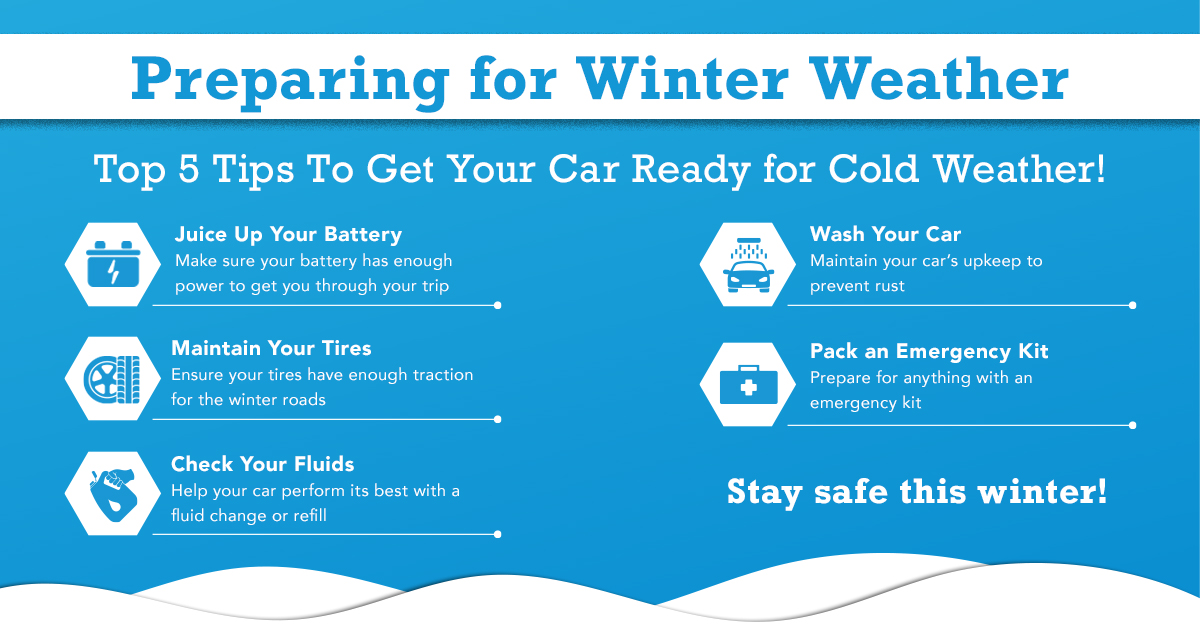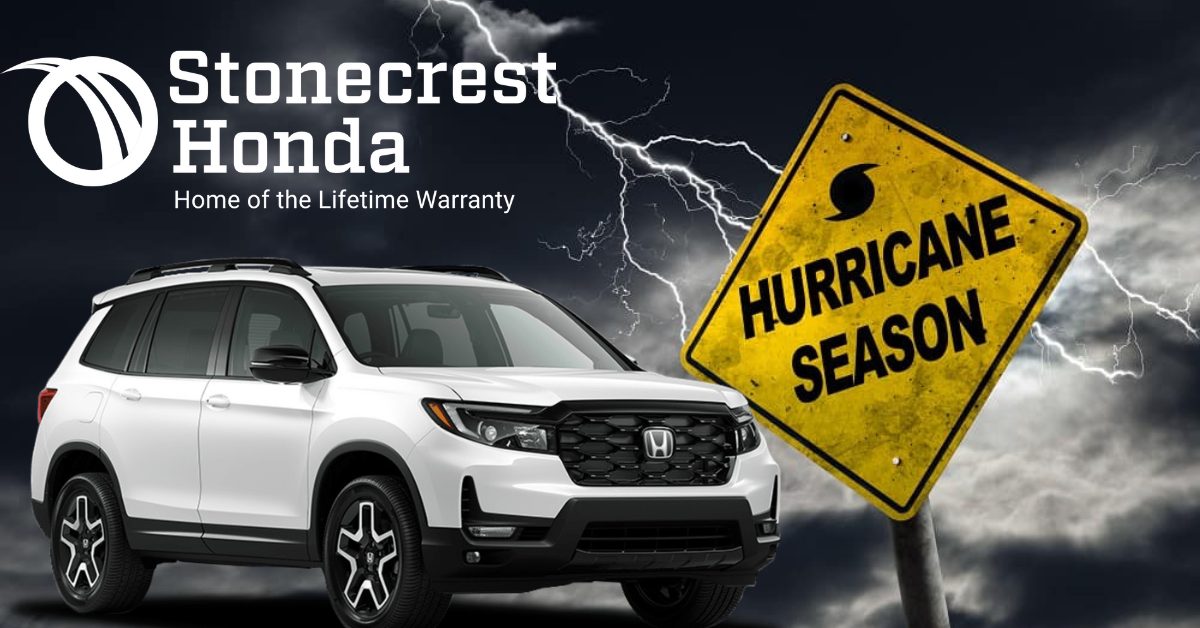5 Simple Ways To Get Your Car Ready for Winter

For the majority of the year, driving conditions are pretty tepid. But the true test of your integrity as a car owner, and the quality of your car comes during the winter months. This is when you can truly get punished for not taking care of your car unless you take care of the necessary winter car prep. Between harsh winter weather and the toll the cold, ice, snow, and salt can take, you really have to step up your winter car care game to get your vehicle winter ready.
Winter Car Care Checklist
We don’t want to see you or your car on the side of the road this winter season. The best way to avoid any issues is to make sure your car is ready to take on whatever the next few months have in store. So before things get really rough, here are 5 simple winter car care tips that will help you and your car be ready for the colder months ahead.
Juice Up Your Battery
Having to wait for a jump in the middle of the cold and possibly snow is up there with the worst things to happen in winter. If you don’t check your battery before the cold weather sets in, you’re really taking a gamble. The extreme cold that we tend to see can make it difficult for your battery to operate. And the last thing you want is to come back to your car left in a cold parking lot and find it dead leaving you with no heat. The best advice you’ll get today is to get a volt test on your battery now. This will tell you what the health of your battery looks like and whether or not you should invest in a new battery.
Maintain Your Tires
When it comes to driving in winter, the quality of your tires is paramount. But it’s not just about what kind of tires you have but keeping an eye on your tire pressure as well. Investing in winter tires or all-season tires is a great idea and one we highly recommend. You want something that you can rely on for snow, rain, mud, and anything else you may encounter this year. However, something that gets overlooked often is tire pressure. As the air gets colder, tire pressure can drop up to one pound per square inch with every 10-degree drop. Keep an eye on your tire pressure and make sure you fill them if they are looking low.
Check Your Fluids
Every fluid in your car is going to help it perform the best it can during the colder months. For this reason, it’s very important that all of your fluid levels are good and fresh. Change your oil and filters if it’s coming near time, flush and refill your coolant/antifreeze, and fill your windshield wiper fluid. Doing all of these now will ensure that your car works the way it should even when temperatures drop.
Wash Your Car
This may seem like a weird thing to do, but it’s surprisingly important. However, this is something that you should do throughout the winter months. As more snow hits the roads, the county will salt those roads in an effort to keep them as clear as possible. But that salt will also end up on your car, especially all over your undercarriage. While the salt really helps the roads, it can wreak havoc on your car and cause rust. That is unless you give it a good wash after a big snow. Both an automatic and manual wash will work, as long as you can hit your undercarriage well.
Pack an Emergency Kit
Everything is all fun and games until your car dies in the middle of a snowstorm. Whether you slid on ice or something happened with your engine, or maybe even ran out of gas, having an emergency kit may just save your life. Depending on the weather and where you are, you definitely need to be prepared for anything. Here are some things you should have packed:
- First-aid kit
- Jumper cables
- Snow brush and ice scraper
- Flares
- Multi-tool with a knife
- Portable charger
- Air pump
- Shovel
- Cat litter or sand
- Candle and lighter
- Thermal blanket
- Snacks and water
Stay Safe Out There
Winter can be a crazy time, but making your vehicle winter ready ahead of time can go a long way. These are just a couple of things you can do, but there’s always more. Do your research and talk with our fantastic service technicians about what you should have done before the colder months are on top of us. Be smart and stay safe this holiday season!
How to Keep Your Honda Safe During a Hurricane

Summer may be over, but we’re still in the thick of hurricane season. While Florida usually gets the brunt of the storms, there are good chances that those strong residual winds, rains, and other terrifying weather will affect the Atlanta area as well. And when that happens, it’s crucial to protect your Honda from the damage these strong storms can cause.
Storms can cause a lot of damage, especially if you’re unprepared. Falling trees or limbs, hail, debris blown around by the strong winds, and all of this and more can pose significant risks to a car sitting out on the street unprotected. And there’s nothing worse than waking up after a crazy storm to see your car dented or windows cracked or broken as a result. While your favorite local Honda experts at Stonecrest Honda are here to help repair any damage, we’d rather you avoid that situation completely. So here are some things you can do to keep your Honda out of harm’s way!
How to Protect Your Car During Hurricanes and Tropical Storms
Strong storms like hurricanes or even severe thunderstorms can produce some crazy weather conditions. These can include hail the size of quarters or larger that can fall at speeds faster than 100 miles per hour, fast and strong winds sometimes reaching speeds of 74 miles per hour, and incredible amounts of heavy rain averaging around 16 inches, all resulting in flooding from storm surges, personal and property damage, and more. If you’ve left your car out on the road in the middle of a hurricane, tropical storm, or even a severe thunderstorm, there’s a good chance that your car will be on the receiving end of some crazy damage from trees, debris, water, and a lot more. We’re here to help give you some tips on how to protect your car in the event of severe weather events and future-proof yourself a bit in the process.
Preparing Your Car For The Storm
Protecting your car from any potential damage is definitely the first thing you should be thinking about. There are a handful of things you can do to prep your car from the barrage of wind, rain, and more that is bound to come during any severe weather event.
- Remove any crucial documents and personal items
- Lock all doors and close windows and moon/sunroofs
- Protect windows and lights with foam and duct tape
- Set your hand/emergency brake to brace your car
- Fill the gas tank
- Use a car cover or large blanket/rug
The number one thing you want to do is secure any and all documents as well as personal items. This can include your insurance cards, registration, and any other important papers you may be keeping in your glove box. In the event of flooding, you definitely don’t want any of those papers to receive any severe water damage. Once you’ve got all you wanted to out of your car, you can begin adding layers of protection. Placing foam against the windows secured with duct tape will support your windows during intense winds. Setting your parking brake gives your car something to brace against in the event of flooding and winds. And of course, covering your car with a heavy blanket paired with a tarp will help protect against falling debris or hail. Filling your gas tank is a really good way to give yourself an out if you suddenly need to move your car or evacuate from your house or apartment. All of this, as well as anything else you come up with, will be great ways to protect your car the best you can from damage during a storm.
Where to Park Your Car During a Storm
Knowing where to park your car during a storm can give you a huge advantage and help you avoid serious damage. It should come as no surprise that parking under a tree or next to the water is probably not the greatest idea during an intense storm. You want a place that does more to protect your car and avoid anything that may easily break off and land on said car. Places like covered parking garages are very ideal, as they provide not only nearly complete coverage on all sides but often place your car at a higher elevation which can protect your car from flooding. You definitely want to avoid basement or low-level parking areas, as those will be the first places to flood during heavy rainfall. However, any enclosed parking space will be more ideal than an open-air parking lot, so if you have a parking garage best make use of it. And even if you’re car is protected on all sides, it’s still a good idea to implement all of the layers of protection. More protection is always a good idea.
Future-Proof Yourself
Before any serious storm, if you’re expecting the chance that your car may be damaged, it may be a good idea to take pictures of the condition of your car BEFORE the storm. Most car insurances do provide a level of natural disaster coverage. However, insurance also typically will look for any reason not to pay out that coverage. If you take pictures of the condition of your car before the storm, you have a solid baseline to compare any damage that may have taken place during the storm. And photo evidence is irrefutable in most cases.
Driving During a Severe Storm
Obviously, it’s not a great idea to head out on the road in the middle of a hurricane or other severe weather event. However, some situations are unavoidable, like having to evacuate from your home or apartment building, or driving back home and you get stuck in a storm. So if you’re going to be driving in the middle of one of the worst situations possible, be smart about it.
The number one thing to avoid is any flooded roads or washed-out bridges. Even if you have a decent off-road vehicle that’s prepared for situations like that, you likely don’t have the necessary training or experience to come out of that unscathed. Find a new route that takes a higher road. Another road hazard to watch for is fallen objects or downed power lines. Storms can bring down a whole manner of branches, whole trees, telephone poles, and power lines that can pose a great risk to you on the road. Don’t take the risk of trying to move the branch and definitely don’t touch downed power lines as they are likely still live and extremely dangerous. Stay in your car and find a way around or a completely new route.
The way you drive will also change depending on the situation. During low visibility and high winds and rain, it’s best to slow down as much as you can. Driving slow allows you to have more time to respond to stalled vehicles or road hazards, while also giving you more control against strong winds.
Stay Safe Out There
Hurricanes, tropical storms, and other forms of severe weather are no joke. They’ve accounted for billions of dollars of damage and countless deaths over the years and we don’t want you to fall victim to the increasing danger these severe weather events bring with them. While these tips are not a guarantee that you’ll avoid any and all danger or damage by any means, they are certainly a good start to protecting yourself and your property. To learn more, please visit https://www.ready.gov/hurricanes and stay safe out there! Remember, a car is replaceable, you are not.





